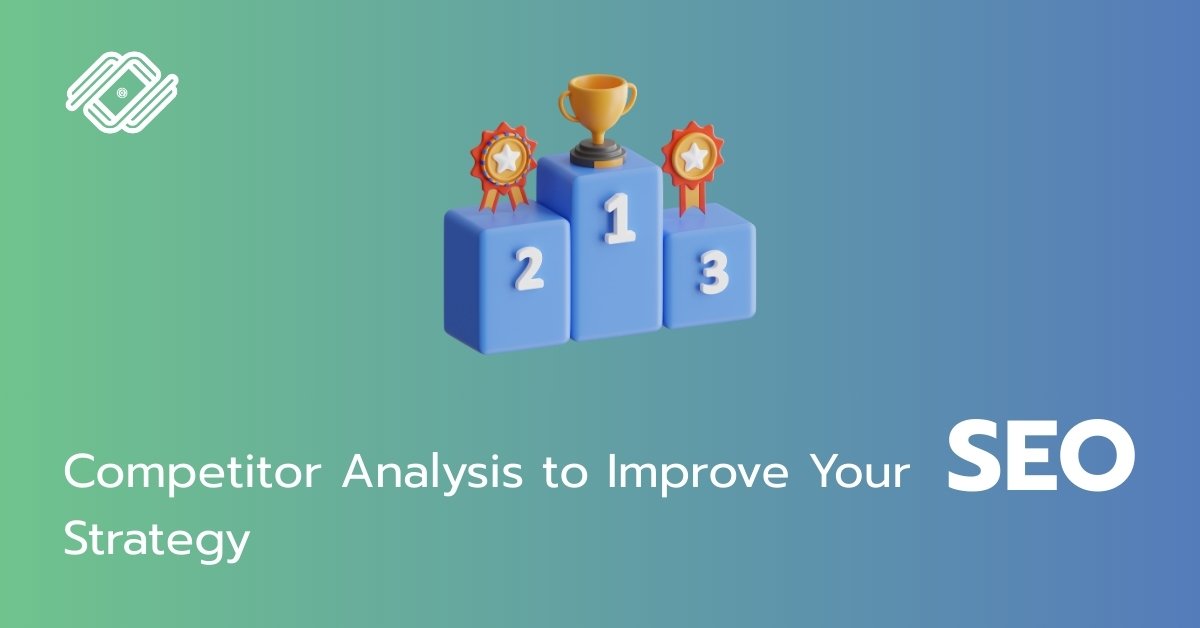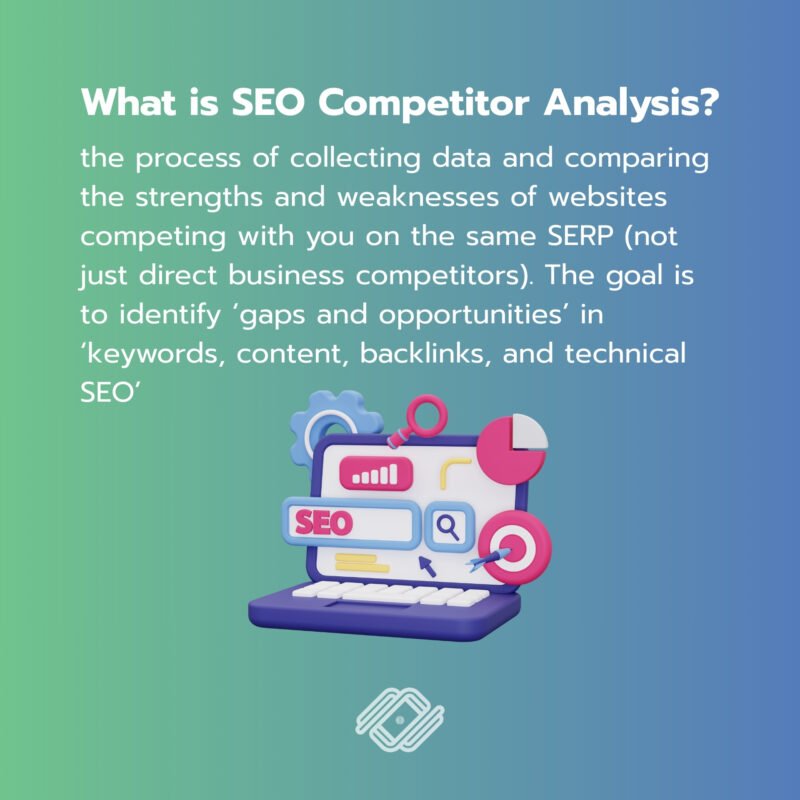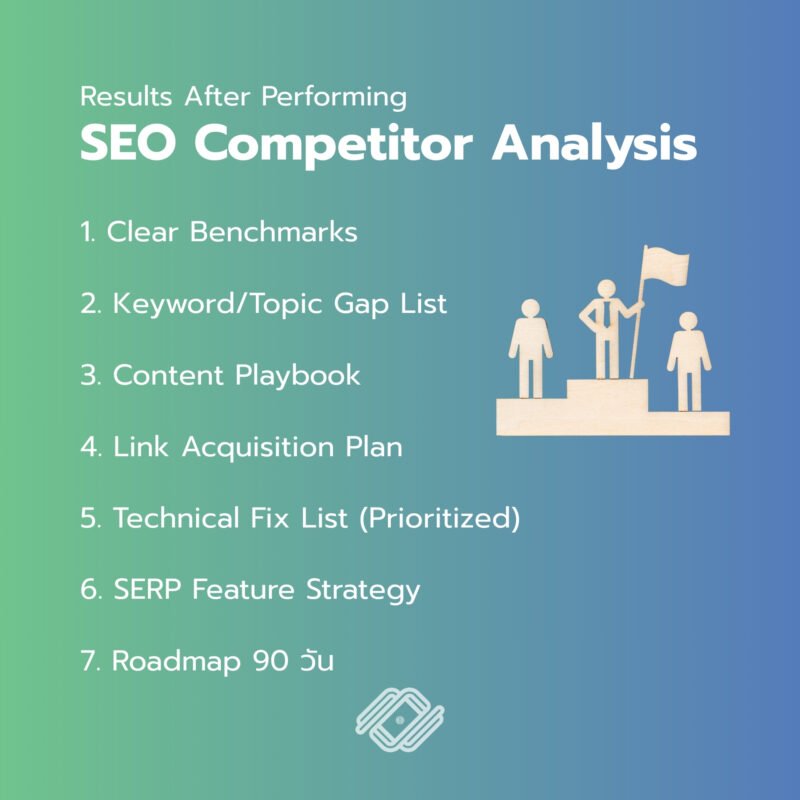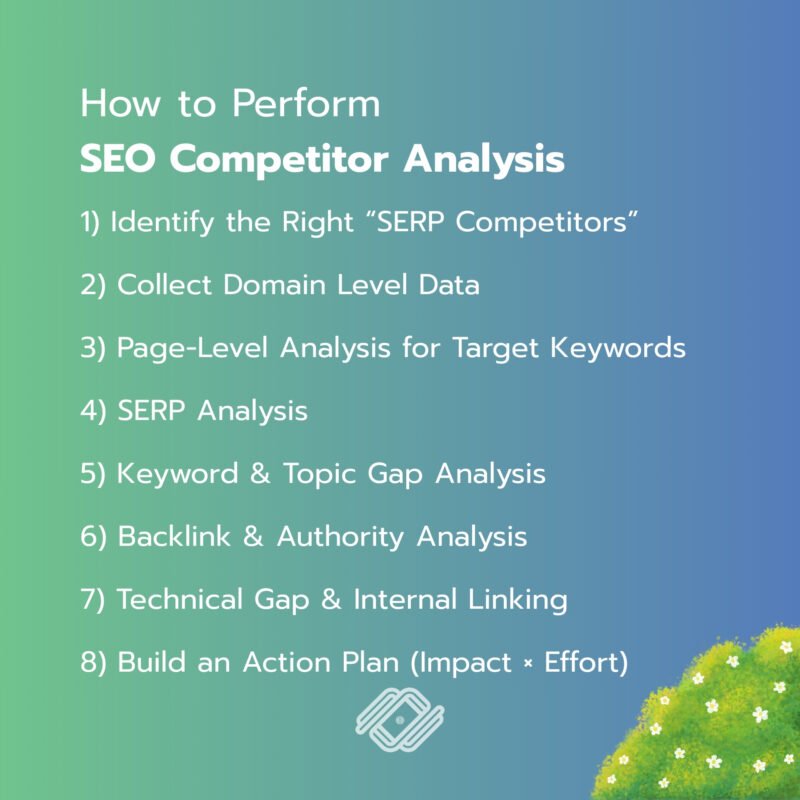
SEO Competitor Analysis is the process of collecting data and comparing the strengths and weaknesses of websites competing with you on the same SERP (not just direct business competitors). The goal is to identify ‘gaps and opportunities’ in ‘keywords, content, backlinks, and technical SEO’ so you can outperform them strategically.
The essence of competitor analysis is not “copying” but learning – adapting – outperforming within your own resource limits.

Results After Performing SEO Competitor Analysis
Once completed, you should gain tangible insights such as:

- Clear Benchmarks
– Average metrics of Top 3/Top 10 results: article length, heading structure, referring domains, Core Web Vitals, etc.
- Keyword/Topic Gap List
– Keywords/topics where competitors rank but you don’t, or where your ranking is weak—along with estimated traffic potential and keyword difficulty (KD).
- Content Playbook
– Content improvement plan: heading structure (H1–H3), missing perspectives/data, use of multimedia (images, tables, videos), E-E-A-T signals (author profiles, references, last updated).
- Link Acquisition Plan
– Target domains linking to competitors, linkable assets to create, and outreach/PR strategies.
- Technical Fix List (Prioritized)
– High-impact issues to fix first: speed, indexability, internal linking, orphan pages, schema, canonical, mobile UX.
- SERP Feature Strategy
– Opportunities for Featured Snippets, People Also Ask, Video/Image packs, Local pack, and how to optimize for them.
- 90-Day Roadmap (Impact × Effort)
– Quick wins, structural improvements, and long-term content/link-building assets.
How to Perform SEO Competitor Analysis

1) Identify the Right “SERP Competitors”
- Search for your primary/secondary keywords and record domains that repeatedly appear in Top
- Separate into:
– Direct: Same type of business.
– SERP-only: Content sites, media, marketplaces.
- Focus deep analysis on 3–5 domains that appear most frequently.
Check carefully: Page type (business vs content), search intent (informational/commercial/transactional/local).
2) Collect Domain Level Data
Key metrics to capture:
- Organic traffic, ranking keywords count.
- Domain strength (DR/DA), category structure, internal linking overview.
- Branded vs non-branded ratio, money pages, hub pages.
Look for patterns: Do they win through authority, topical breadth, or UX/speed?
3) Page-Level Analysis for Target Keywords
Pick 10–20 core keywords and compare Top 3–5 pages.
On-page & Content
- H1–H3 structure and covered subtopics.
- Depth, completeness, relevance to search intent.
- Use of multimedia (tables, step-by-step, checklists, videos, images with alt text).
- E-E-A-T signals: author profile, references, last updated, editorial policy.
- Internal links: anchors, in-content placement.
Technical & UX
- LCP/CLS/INP, page size, above-the-fold content.
- Schema (Article, FAQ, HowTo, Product, LocalBusiness, etc.).
- Mobile-first design, table of contents, jump links.
4) SERP Analysis
The SERP itself reveals Google’s preference:
- Content type (guides, lists, tools, products).
- SERP features present (Featured Snippet, PAA, Video, Image, Local Pack).
- Title/meta patterns with strong CTR.
- Gaps: unanswered questions, additional intent (price, compare, review, near me).
Pro tip: Create a “pillar article + cluster articles” covering all related subtopics.
5) Keyword & Topic Gap Analysis
- Collect competitor keywords you don’t rank for, or rank >
- Group by search intent and user journey stage (Discover → Learn → Compare → Buy → Retain).
- Score each by Potential (volume × CPC) and Difficulty.
- Prioritize 10–15 high-potential / medium-to-low difficulty opportunities.
6) Backlink & Authority Analysis
- Identify domains linking to competitors but not you (Link Intersect).
- Rank by relevance, real traffic, and anchor diversity.
- Find competitors’ linkable assets (annual reports, free tools, templates, data studies).
- Plan outreach/PR: data-driven news, guest posts, partnerships, resource pages.
7) Technical Gap & Internal Linking
- Crawl both your site and competitor winners: check status codes, canonicals, hreflang, sitemaps, robots.
- Internal Link Flow: Build hub/cluster structures, use anchor text with topical relevance, link from strong pages to money pages.
- Optimize Core Web Vitals, compress scripts/images, use lazy load, next-gen formats.
8) Build an Action Plan (Impact × Effort)
Quick Wins (0–30 days)
- Optimize titles/meta for intent & CTR.
- Add FAQ/HowTo schema for rich results.
- Add internal links from strong pages to target pages.
- Refresh old articles: update data, references, expert summary.
Mid-term (30–90 days)
- Produce 10–15 cluster content pieces from topic gaps.
- Build 1–2 linkable assets + outreach.
- Restructure categories, TOC, UX for readability/speed.
Long-term (90+ days)
- Strengthen brand signals: author profiles, about/team pages, customer reviews.
- Ongoing digital PR, build unique tools/databases.
9) Measure and Iterate
- North Star Metric: Organic revenue/leads from non-branded traffic.
- Supporting metrics: Clicks/Impressions (GSC), avg. position, CTR, topical coverage, quality referring domains, Core Web Vitals.
- Review cycle: every 4–6 weeks, re-benchmark against the same competitor set.
Recommended Tools (Choose per budget/skills)
- Keyword & Content Gaps: Google Search Console, Ahrefs/SEMrush, Keyword Planner
- Backlinks & Link Intersect: Ahrefs/SEMrush, Majestic
- Crawl & Technical: Screaming Frog/Sitebulb, PageSpeed Insights, GSC Indexing
- SERP & CTR: GSC, SEO Minion
Task Management: Google Sheets/Notion, Kanban (Trello, Jira)
Pro Tips to Win Faster
- Match intent precisely: Top-ranking pages for a keyword often share a content format—replicate it, but go deeper.
- Offer unique value: Data insights, comparison tables, free tools, downloadable templates.
- Strategic internal linking: Channel authority from strong pages to money pages with keyword-rich anchors.
Refresh content regularly: Update stats/examples every 3–6 months for competitive topics.
—
If you want your business to reach online customers and achieve sustainable marketing results, we are happy to provide consultation on what you need.
For further inquiries, contact us at:
Tel. 093 696 4498 Line OA: https://lin.ee/po8XduU
E-mail: mongkontep@pkindev.com
Inverze Solutions Co., Ltd. has received numerous awards for its achievements
ย
